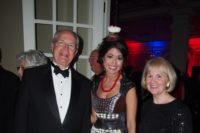![]()
The Candy Elite
They are of another class and they are rapidly multiplying
— are you properly showcasing these quality confections?
Upscale candy is everywhere. It continues to be one
high-end item that consumers don’t want to cut back on — in
fact, just the opposite — they are cutting back on bigger, expensive
luxury items and splurging more on good quality chocolate and confections.
Packaged like expensive jewels in colored foils, then elegantly boxed or
tinned or bowed or laced up — they have become the perfectly
pre-wrapped gift for everyone, even oneself.
The first order of business should be some familiarity
with this lavish assortment. It will quickly become obvious: This is not
your kid’s candy.
What it is — a work of confection art: Long
rectangular marshmallows, coated in chocolate, drizzled in
holiday-coordinated icing and situated on a high-quality wooden stick,
wrapped in cellophane with a matching bow; white chocolate wafers (that
resemble waffles) sandwiching caramel crème, individually wrapped in
gold cellophane, packaged in a waffle-shaped mini-hat box; thick,
high-cocoa-content chocolate barks topped with coffee beans, toffee chunks
or peppermint candy shavings, shaped into a large rectangle or square, then
wrapped in clear cellophane and perfectly fitted with a matching nostalgia
tin to nestle in.
Then there’s logo taffy; marshmallows completely
covered in sprinkles and packaged like truffles; freeze-dried raspberries
blended into marshmallows, caramel/nut clusters packaged like truffles;
eggnog white chocolate squares; European “drinking chocolate,”
liquor-filled chocolate balls; and lollipops, jelly beans and hard candies
flavored for the adult set with varieties such as hazelnut coffee, double
latte, Aztec mocha, spicy amaretto, raspberry espresso, orange marmalade,
bittersweet peppermint, and mulled apple cider. And that’s just a
small taste of what’s emerging.
Imperatives
While a few upscale makers are gracing the mass market with
some wonderful less-expensive versions of their candy (typically forgoing fancier
packaging), others are simply selling their traditional higher-priced treats
(fancy packaging and all) to any retailer that is willing to take on the better
margin. The challenge for these retailers (from supermarkets to meat markets
to drugstores to home stores) is this: Do they know how to boutique it as the
special gift item it is? For it certainly doesn’t belong in the regular
candy aisles (if indeed, the store even has candy aisles). The bottom line literally
is: Do they know how to showcase it against non-food items in their stores?
Indeed, many are just starting to learn (taking their cue from fancy gourmet
and department stores) — and not a moment too soon for the more discriminating
American sweet tooth.
Consumers
It should come as no surprise that the baby boomers
have inspired more action in this category. While they were always a
consumer group of great spending and self-spending, they have now matured
into wanting quality items that are of greater value — but not
necessarily of substantially greater price. Like the rest of the country,
they are watching their dollars more carefully, but since candy is
relatively inexpensive when compared to other luxury items, they will spend
there — as long as it’s something novel and high quality. Thus,
product innovation is kept at an all-time high for premium/gourmet candy.
Another influence in the category that is strongly led by baby
boomers: A significant distribution of retro and nostalgia items, especially
in the packaging (such as tins and hat boxes).
Marketing
Gourmet candy reinforcement is in high gear from
upscale manufacturers. They know this category would be nowhere without its
marketing and packaging — so no doubt, these aspects will continue to
be well fed.
It seems like packaging couldn’t get any more
innovative — although of course it probably will — next year.
Right now, tins and hat boxes prevail. There is consistency in themes and
in the “look and feel” throughout the seasons. Major design
trends in packaging include: Simple, clean, bold graphics; artisan-style
with handwritten lettering; a natural rough look; and memory
retro/nostalgic (think Laura Ashley paisley and stripes).
We’re also seeing nutritional concerns reflected
in this category. Functional, sugar-free and low-carb options are
proliferating. Many European-style chocolates have product benefits right
on the package (for example: high in fiber, helps metabolism, etc.). Many
chocolate companies have added “GMO free” on their ingredient
labels. And marketing “chocolat d’origine,” or
chocolate identified by its country of origin, is also a big push. In
addition, chocolate makers report that more and more consumers are
interested in knowing the exact cocoa content of the chocolate they
purchase, so that is reflected on some labels as well.
Beyond packaging, there’s another good marketing
force: Many of these makers also have catalogs to reinforce purchase
decisions. Experts say it’s a nice connection and good way to promote
the entire category now that the segment is cropping up in multiple retail
channels. Catalogs also reinforce the upscale quality and pricing and are
typically premium (as in paper, artwork and design elements) themselves.
Marketers in this category are used to dealing with the upscale
retail channel, and so they typically are very willing to offer added services
to their masterpiece candies, i.e. to price it differently; affix a proprietary
logo; ship it in a special carton, create upscale display shippers, etc. Industry
observers say the trade is getting much more efficient at this, not to mention
using technology such as EDI, and are thus, more prepared to come in and cater
to other retail markets.
Outlook
And for an option that is truly in a new realm,
imagine chocolate or high-quality confections that you wear: Candy makers
already have, and thus, it is predicted to be the next wave in gourmet
candy. Combining candy with ideas from the accessory world — this
totally wild trend is still on the drawing board, but might include items
such as wrist bands that house a case that resembles a watch, but is
actually filled with mints or mini candies; lipstick cases that swivel up
edible chocolate; leather hip belts that hold gum. The idea is to use the
latest apparel and accessory technology to leverage more candy for those
that like to have a small treat every day. Please note: While it may later
catch on with teens and tweens, these initial ideas are highly upscale and
will be targeted to confection-loving adults.
And it is these adults — with their more mature and sophisticated
palates — who can be expected to ensure that sales in the premium confections
category will continue to outpace the mainstream.
Merchandising Musts
Showcase, spotlight, highlight, segregate.
This upscale candy category doesn’t do well when it’s positioned as a treasure hunt. Consumers often will not go looking for specialty candy, mostly because they don’t know exactly what exists. So retailers want customers to literally walk into the store and stumble upon these premiere displays.
This upscale candy category doesn’t do well when it’s positioned as a treasure hunt. Consumers often will not go looking for specialty candy, mostly because they don’t know exactly what exists. So retailers want customers to literally walk into the store and stumble upon these premiere displays.
Some successful retailers are even positioning chocolate boutiques
near complementary specialty items such as coffees, gourmet desserts or fresh-baked
goodies. Others are calling attention to the gift aspect of the category
and inter-mingling it on displays that include non-consumable items. Either
way, fancy presentation is key to sales. Rustic wood tables, overhead wire baskets,
gilded trays — are all being used to call attention to the products.
Demo, Demo, Demo.
Especially if this is a new category for a retailer, in-store sampling and tasting demonstrations must be incorporated into the merchandising of gourmet candy. Experts say the best times are two to three weeks before popular holidays such as Thanksgiving, Christmas, Valentine’s Day and Mother’s Day.
Especially if this is a new category for a retailer, in-store sampling and tasting demonstrations must be incorporated into the merchandising of gourmet candy. Experts say the best times are two to three weeks before popular holidays such as Thanksgiving, Christmas, Valentine’s Day and Mother’s Day.



